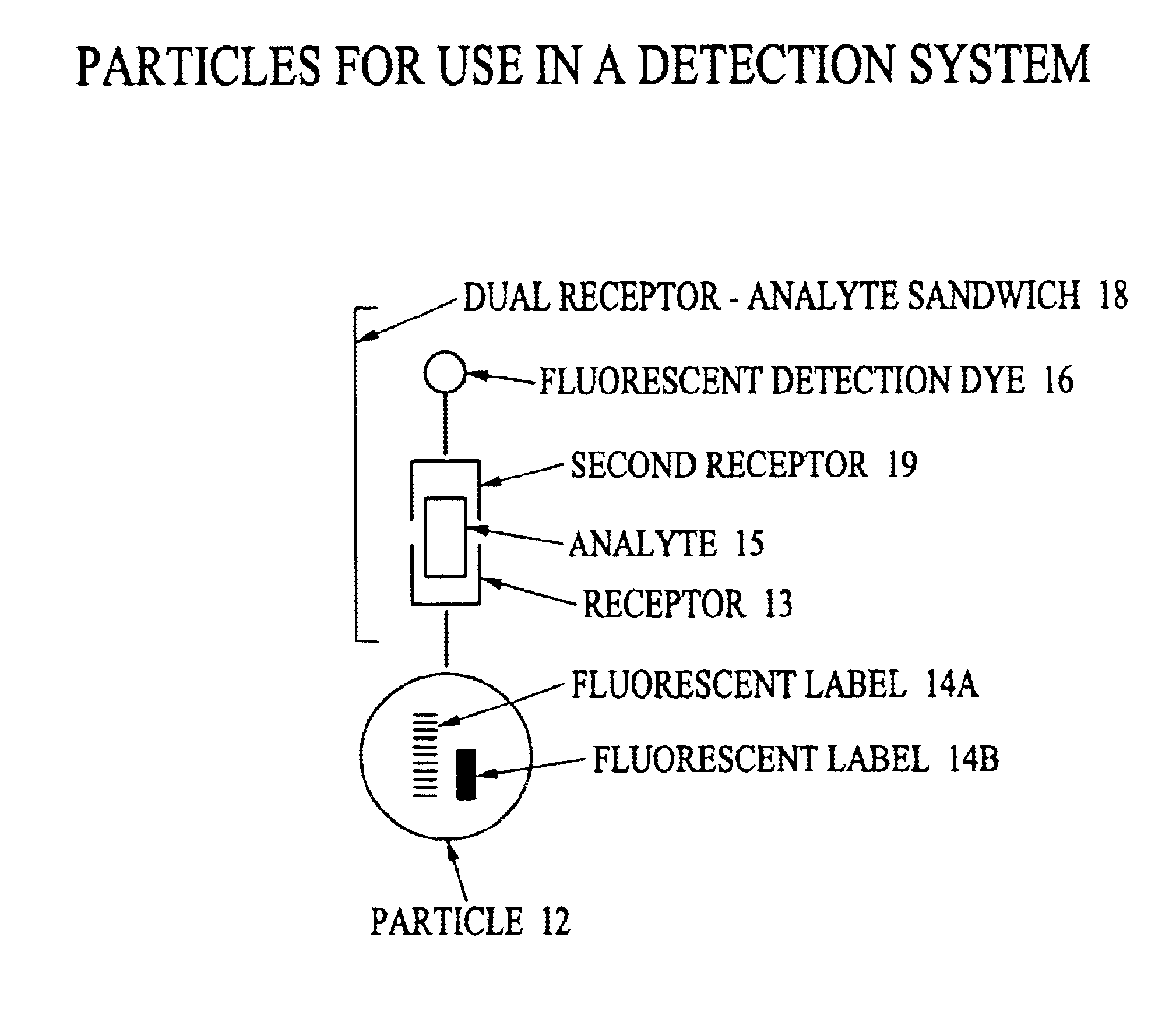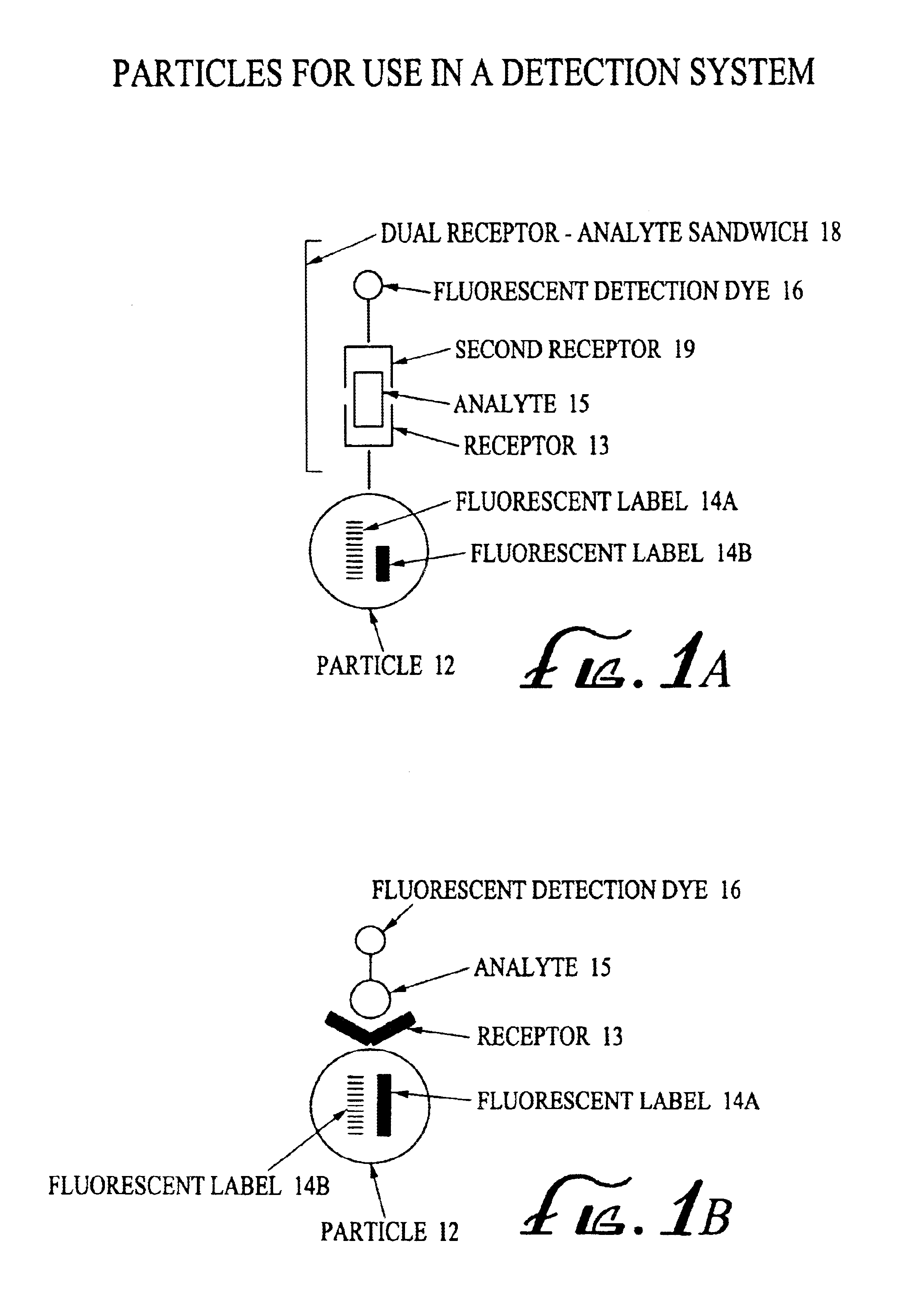Analyte detection system
a detection system and analyte technology, applied in the field of detection systems, can solve the problems of disadvantaged prior systems employing multiple fluorescent labels, affecting the detection and quantification of analyte in these systems, and difficult to measure the absorption of particles, etc., and achieve the effect of time efficien
- Summary
- Abstract
- Description
- Claims
- Application Information
AI Technical Summary
Benefits of technology
Problems solved by technology
Method used
Image
Examples
example1
Cyanine Compounds Employed as Fluorescent Labels
IR-792 perchlorate, as shown below in Structure D, is a commercially available fluorescent label, useful in the present invention. IR-792 perchlorate, commercially available from Aldrich Chemical Company, is a fluorescent ring-locked cyanine compound that is excited by a 782 nm diode laser with a fluorescence emission frequency of 821 nm. The compound has good solubility in methylene chloride and stability in methylene chloride over time. FIG. 4, an overlay of the emission spectra of IR-792 perchlorate in methylene chloride for a two-month period, shows the stability of IR-792 perchlorate in solvent over time.
Structure D. IR 792 Perchlorate.
As an example of a pair of fluorescent labels used for particle coding, IR 792 perchlorate is incorporated in combination with Compound 6 according to the present invention. Compound 6 is excited by a 782 nm diode laser and has a fluorescence emission of 863 mm. Compound 6 has good solubility and s...
example 2
Ring-Locked Dibenzocyanine Compounds Used as Fluorescent Label Pairs
In another example, fluorescent Compounds 5a and 5b and Compounds 5c and 5d are employed in combination as fluorescent labels for coding particles. Compounds 5a-d are ring-locked dibenzocyanine compounds with a pair of extended alkane side chains. The label pairs differ by the inclusion or absence of a chlorine atom attached to the cyanine backbone above the locking ring. The alkane side chains increase the solubility of the charged labels in particle solvents and polymers and the stability of the labeled particles. Inclusion of the chlorine atom in the cyanine backbone causes the molecule to both absorb and emit at longer wavelengths than molecules that lack the chlorine atom. Table 3 summarizes the spectral data for Compounds 5a-d.
TABLE 3Summary of Spectral Data for Compounds 5a-d.λmaxEm.Compound(methylene chloride)(methylene chloride)5a787 nm833 nm(Ex. 782 nm)5b820 nm860 nm(Ex. 782 nm)5c787 nm833 nm(Ex. 782 nm)5d...
example 3
Preparation of Compound 6, [2-[2-[2-Phenylsulfyl-3-[(1,3-dihydro-3,3-dihydro-3,3-dimethyl-1-propl-2H-benzoindol-2-ylidene)ethylidene]-1-cyclohen-1-yl]ethenyl]3,3-dimethyl-1-propylbenzoindolium] Iodide
Preparation of N-propyl-1,1,2-trimethyl-1H-benzyl indole iodide (2, R═(CH3)2CH3). To a one-neck round bottom flask, equipped with stir bar, was charged with 1,1,2-trimethyl-H-benzyl-indole (2 g, 9.6 mmole, 1) and iodopropane (2.4 g, 14.3 mmole). The flask was placed in an oil bath (pre-heated at 90 EC) for 24 hrs under N2. The resulting reaction mixture was allowed to cool to ambient temperature and filtered. The solid was washed with iodopropane (5 mL), hexane (50 mL), and dried under vacuum at 60° C. for 6 hrs gave 3.2 g of a red colored solid in 88% yield. 1H NMR (CDCl3) δ ppm: 1.15 (t, 3H), 1.88 (s, 6H), 2.08 (m, 2H), 3.21 (s, 3H), 4.79 (t, 2H), 7.67-7.74 (m, 2H), 7.82 (d, 1H), 8.04-8.13 (m, 3H). 13C NMR (CDCl3) δ ppm: 11.29, 16.82, 21.62, 22.69, 51.44, 55.83, 112.54, 122.76, 127.55...
PUM
| Property | Measurement | Unit |
|---|---|---|
| maximum wavelengths | aaaaa | aaaaa |
| excitation wavelengths | aaaaa | aaaaa |
| excitation wavelengths | aaaaa | aaaaa |
Abstract
Description
Claims
Application Information
 Login to View More
Login to View More - R&D
- Intellectual Property
- Life Sciences
- Materials
- Tech Scout
- Unparalleled Data Quality
- Higher Quality Content
- 60% Fewer Hallucinations
Browse by: Latest US Patents, China's latest patents, Technical Efficacy Thesaurus, Application Domain, Technology Topic, Popular Technical Reports.
© 2025 PatSnap. All rights reserved.Legal|Privacy policy|Modern Slavery Act Transparency Statement|Sitemap|About US| Contact US: help@patsnap.com



